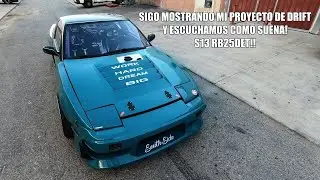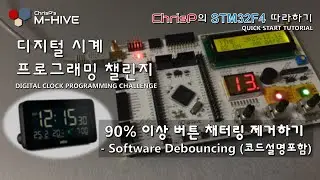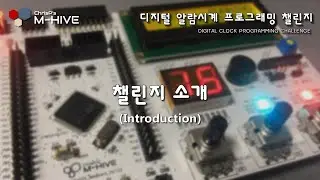[STM32 Drone programming from scratch] 0-2. Contents introduction and install STM32CubeIDE.
This video introduces the contents of the lecture and explains how to download and install CubeIDE for STM32 firmware development.
M-HIVE "STM32 Drone programming from scratch"
This is the only course about the drone embedded system development from sensor interface, the most basic feature, to PID control for the flight control.
☆★ Buy an MH-FC V2.2 and drone parts ☆★
https://www.m-hive.net/
☆★ Download source code ☆★
https://github.com/ChrisWonyeobPark/M...
☆★ Overview of the "STM32 Drone programming from scratch" course ☆★
• [STM32 Drone programming from scratch...
☆★ Contents of the course ☆★
• [STM32 Drone programming from scratch...
☆★ Introduction to the drone parts ☆★
• [STM32 Drone programming from scratch...
☆★ Students' achievements ☆★
by 문종현
• 엠하이브 STM32 자작드론 개발하기 - 실내비행 (편집영상)
• 엠하이브 STM32 자작드론 개발하기 - 실내비행 (편집영상)
• 엠하이브 STM32 자작드론 개발하기 - Fail-Safe 기능
by apple_tree
• STM32CubeIDE를 이용한 STM32F4 자작드론 개발하기 -...
by 두두
• Video
• Video
by Gyuseob Choi
• STM32F405 자작드론 개발하기 - 엠하이브 강의 드론 비행 테...
by HY's Embedded LAB
• Flight Test 2
This video includes
0:00 How to download a drone parts purchase list pdf file
1:29 What is STM32CubeIDE?
4:38 Download and install STM32CubeIDE
6:55 Course contents
33:27 Launch STM32CubeIDE
FC development will begin in earnest from next time.
Enjoy the course.
Thank you!
Do you want to build your own high performance drone flight controller with arm cortex micro-controller?
Do you want to add specific functions to your drone?
Is it too difficult to develop drones using the open-source such as ArduPilot or PX4?
→ Here is the easiest way in the world to make your own drone flight control system firmware!!
→ You can build high-performance STM32 flight control system with this course!!
This is the only course that explains how to build the flight control system for high-performance self-made drone using STM32 with STM32CubeIDE, a free IDE. Since we implement everything from GPIO, sensor interface to motor drive and PID control NOT USING OPEN SOURCE SW/HW SUCH AS PIXHAWK, ARDUPILOT OR PX4, you can learn and understand all the development processes of drone control system and embedded system.
Moreover, the flight performance of the drone developed in this course is not inferior to that of commercial products such as pixhawk and ardupilot, so it can be applied to research and industrial applications beyond educational drones. Also, the MH-FC V2.2 can be applied not only to drones, but to all moving devices, so it can be applied to systems like unmanned vehicles!
I will explain all source code and hardware assembly methods step by step so that even non-majors and beginners can easily follow this course. If you follow all of this course, you can make your own drone flights stable like other commercial products that you developed yourself.
The lecture consists of 3 parts, 12 chapters and 51 sessions. (Total 31 hours)
The course contents are as follow(MH-FC V2.2 required):
● In Part 1. Flight control system development fundamentals
CH1. Setting up the development environment for STM32 embedded system
CH2. Sensor interface / attitude measurement - BNO080 9-axis sensor, ICM-20602 6-axis sensor, LPS22HH barometric pressure sensor (SPI)
CH3. GPS data receiving and decoding - NEO M8N (UART)
CH4. Transmitter and receiver, data receiving and decoding - FS-i6 transmitter, FS-iA6B receiver based on iBus serial protocol (UART)
CH5. Drone parts assembly (QAV210 frame)
CH6. BLDC motor control - Oneshot125 PWM protocol (TIM-PWM)
● In Part2. Communication and additional features
CH7. Additional features - EEPROM interface (I2C), battery voltage checker (ADC), BNO080 calibration, gyro DC offset removal
CH8. Radio data communication (FC↔GCS) (Transmitting drone status information and receiving control parameters, how to use Ground Station dedicated to this course)
CH9. Safety functions - Fail-safe motor stop and low battery alarm for safety
● In Part3. Flight control using PID Control
CH10. Preparation for PID control
CH11. Roll, pitch control (Cascade PID)
CH12. Heading control (Single PID)
In this course, the STM32F405 Cortex M4 microcontroller is used as a main processor, the BNO080 9-axis and ICM-20602 6-axis sensor for attitude control, the LPS22HH barometric pressure sensor for altitude control. It also covers receiving ublox M8N GPS data for outdoor automatic flight. (However, altitude control and GPS control are not covered in this course)






![[FREE / フリートラック] JAKEN × 18stop Type Beat](https://images.mixrolikus.cc/video/L-7azJE_fz8)

![[디지털 알람시계 프로그래밍 챌린지] 10. 알람설정모드 구현](https://images.mixrolikus.cc/video/4PKj6RI0CzE)
![[디지털 알람시계 프로그래밍 챌린지] 9-2. 알람반복기능 추가](https://images.mixrolikus.cc/video/AHUb28yCz3c)
![[디지털 알람시계 프로그래밍 챌린지] 9. 알람모드 구현](https://images.mixrolikus.cc/video/Imjb-clllDA)
![[디지털 알람시계 프로그래밍 챌린지] 8. 시간설정모드 구현](https://images.mixrolikus.cc/video/Q4h4EK0LRmM)
![[디지털 알람시계 프로그래밍 챌린지] 7. 시계 구현 - 날짜 및 시간 표시, 윤년 적용](https://images.mixrolikus.cc/video/Jp45WynK1Ls)
![[디지털 알람시계 프로그래밍 챌린지] 6. 버튼 이벤트 다양화3 및 부저 - SHORT-MID / MID-LONG 경계](https://images.mixrolikus.cc/video/WfgRcvC08V0)
![[디지털 알람시계 프로그래밍 챌린지] 5. 버튼 이벤트 다양화2 - SHORT / MID / LONG HOLD](https://images.mixrolikus.cc/video/ovAJExhEP38)

![[디지털 알람시계 프로그래밍 챌린지] 4. 버튼 이벤트 다양화1 - SHORT / MID / LONG PRESS](https://images.mixrolikus.cc/video/6k6Cy8T3jrk)
![[디지털 알람시계 프로그래밍 챌린지] 3. 스탑워치 - CLCD에 시간표시, 랩타임 저장 및 표시](https://images.mixrolikus.cc/video/zlINlP8Xwh0)
![[디지털 알람시계 프로그래밍 챌린지] 2. 스탑워치 - 7-Seg에 시간표시, 버튼으로 조작](https://images.mixrolikus.cc/video/JX66f2jckEo)
![[디지털 알람시계 프로그래밍 챌린지] 1-3. 버튼 누른 시간 카운트](https://images.mixrolikus.cc/video/ARtBX-rpjCA)
![[디지털 알람시계 프로그래밍 챌린지] 1-2. 버튼 입력 및 UART 입력으로 LED 토글](https://images.mixrolikus.cc/video/Bg9hrV3UmNI)
![[디지털 알람시계 프로그래밍 챌린지] 1-1. 버튼 입력으로 LED 토글 1](https://images.mixrolikus.cc/video/kQcF4ELYz64)


![[STM32 Drone programming from scratch] 13. Conclusion (2/2) - COMPLETE](https://images.mixrolikus.cc/video/_XR-PZF0Tvs)
![[STM32 Drone programming from scratch] 13. Conclusion (1/2)](https://images.mixrolikus.cc/video/mK70bJsz8I0)
![[STM32 Drone programming from scratch] 12-2. Yaw axis heading angle single loop PID control](https://images.mixrolikus.cc/video/SpuxyH5XGIE)
![[STM32 Drone programming from scratch] 12-1. Yaw axis angular rate single loop PID control](https://images.mixrolikus.cc/video/0kGSqGJrnA8)
![[STM32 Drone programming from scratch] 11. Roll and pitch axis double loop PID control](https://images.mixrolikus.cc/video/d17R_sJVhgo)
![[STM32 Drone programming from scratch] 10-3. Double loop cascade PID control - Implementation (2/2)](https://images.mixrolikus.cc/video/pxl86fuKYb4)
![[STM32 Drone programming from scratch] 10-3. Double loop cascade PID control - Theory (1/2)](https://images.mixrolikus.cc/video/yMG_2ZDpM8w)
![[STM32 Drone programming from scratch] 10-2. Single loop PID control - Implementation (2/2)](https://images.mixrolikus.cc/video/IYWzrqLBFpk)